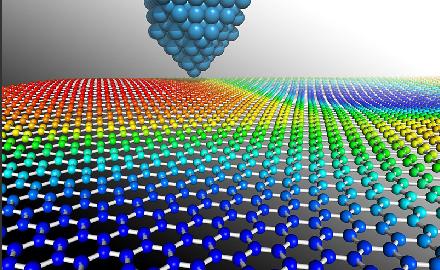A new method for splitting multilayer materials, such as graphite, into monoatomic sheets, could lead to the development of revolutionary technologies in the fields of electronic components and energy storage.

A new method for splitting multilayer materials, such as graphite, into monoatomic sheets, could lead to the development of revolutionary technologies in the fields of electronic components and energy storage.
An international team of researchers, led by scientists from the University of Oxford and the University of Dublin, invented a versatile method to create these nanosheets in the thickness of a single atom from a variety of materials using mild ultrasonic pulses, of the type created by jewelry cleaning devices, and common solvents. The new method is simple, fast and cheap, and can be used on an industrial scale. The research findings were published in the prestigious journal Science.
Each layer of graphite with a thickness of one millimeter contains about three million layers of graphene - a flat layer of carbon with a thickness of a single atom - stacked one on top of the other. "Due to these extraordinary electronic properties, the material graphene received a lot of attention, and was even the basis for the last Nobel Prize in Physics, and researchers in the field hope that one day it will be able to replace the material silicon in the electronic components of the future," says Dr. Valeria Nicolosi from the University of Oxford. "However, in fact, we have hundreds of other multilayer materials that we can use in order to develop innovative and efficient technologies."
One of the researchers adds and says: "In these innovative materials lie chemical and electronic properties that are very suitable for the applications of new electronic devices, extremely strong composite materials and devices for creating and storing energy. And in particular, this research represents an important breakthrough in the development of efficient thermoelectric materials."
There are more than one hundred and fifty multilayer materials of this fascinating type - such as boron nitride, molybdenum disulfide and tungsten disulfide - which have the ability to become a metallic, semi-metallic or semi-conducting material, depending on their chemical composition and the defined arrangement of their atoms.
For decades, scientists have been trying to produce nanosheets from these types of materials, since layers the thickness of a single atom could enable the discovery and utilization of extraordinary electronic and thermoelectric properties. However, all previous methods were lengthy and laborious and, in addition, the resulting materials were brittle and unsuitable for most required applications.
"Our innovative method offers low costs, very high utilization and extremely high power: within a few hours and with the help of only one milligram of the material, it is possible to obtain millions upon millions of graphene-like nanosheets with a thickness of one atom from a wide variety of fascinating multilayer materials, ” notes the researcher.
The nano-sheets, created with this method, can be sprayed on the surface of other materials, similar to silicon, to obtain "hybrid layers" that can be incorporated into existing processes and methods. These materials could be used in the development of innovative computing devices, sensors and batteries.
The news about the study

3 תגובות
One layer of carbon atoms is not graphite but graphene
There was an attack on the site last week, but we managed to eliminate it and increased the security on the servers and the management system. When did you receive the message?
Reported Attack Page! This web page at http://www.hayadan.org.il has been reported as an attack page and has been blocked based on your security preferences.
Attack pages try to install programs that steal private information, use your computer to attack others, or damage your system.
Some attack pages intentionally distribute harmful software, but many are compromised without the knowledge or permission of their owners.